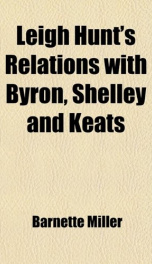leigh hunts relations with byron shelley and keats

Purchase of this book includes free trial access to www.million-books.com where you can read more than a million books for free. This is an OCR edition with typos. Excerpt from book: CHAPTER V Characteristics of the " Cockney School"Reasons for Tory enmity Establishment of Blackwood's Magazine and the Quarterly ReviewTheir methods of attackOther targetsAuthorship of anonymous articlesMembers of the Cockney groupByronHuntKeatsShelleyHazlitt. The word " Cockney" says Bulwer-Lytton, signifies the " archetype of the Londoner east of Temple Bar, and is as grotesquely identified with the Bells of Bow as Quasimodo with those of Notre Dame."1 The epithet remains doubtful in origin but is proverbially significant of odium and of ridicule. R. H. Home asserts that, in its first application, it meant merely " pastoral, minus nature."2 The word did not long carry so harmless a connotation. It was first applied to Hunt by the Tory journals in 1817 and, in the phrase " Cockney School," was gradually extended until it included most of his associates. The group of men thus arbitrarily banded together did not form a school or cult, and themselves resented such a classification. They differed widely in their fundamental principles of life and art. They were not all of one vocation. On the other hand they had certain superficial points in common which made them collectively vulnerable to the dart of the enemy. They were Londoners8 by birth or by adoption; with the exception of Shelley they may all be said to have belonged 1 Charles Lamb and Some of His Companions in the Quarterly Review of January, 1867. 'A New Spirit of the Age, p. 182. ' Near the close of his life Hunt wrote: " The jests about London and the Cockneys did not affect me in the least, as far as my faith was concerned. They might as well have said that Hampstead was not beautiful, or Richmond lovely; or that Chaucer and Milton were Cockneys when they went out of London to lie on the grass ...
Info about the book
Author:
Series:
Unknown
ISBN:
0300018762
Rating:
3.5/5 (3)Your rating:
0/5
Languge:
English
Users who have this book
Users who want this book
What readers are saying
What do you think? Write your own comment on this book!
write a commentGenre
if you like leigh hunts relations with byron shelley and keats try:
Other books by this author
Do you want to read a book that interests you? It’s EASY!
Create an account and send a request for reading to other users on the Webpage of the book!


